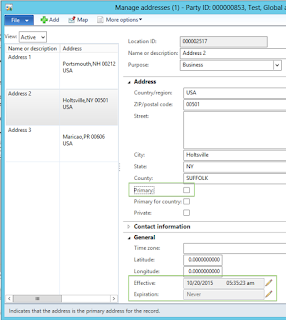Recently I got a request to provide a function to classify a
team (customer specific date effective classification). The goal was to make the process simple and user friendly. My suggested solution was accepted. I want to share it, so probably it can be re-used.
Problem description
Several
classifications are defined. Only one
classification can be assigned to a team at any given time. The current
classification is presented in
Teams form. If current
classification is not defined then
Classification field is empty. The user can simply set new
classification by selecting a new value in lookup. If new
classification is set, previous
classification is made ineffective. Future
classification is taken into consideration for new
classification validity period. The user can manually update
classifications effective dates in
Party form.
Steps to reproduce
1. Define
classifications
To simplify it - let's assume that "Class1", "Class2", "Class3" are defined
2. Add "Class1" in
Party form for new "Team 1"
Effective (ValidFrom) set equal to (today - 7 days),
Expiration (ValidTo) left without changes.
3. Add "Class3" as future period in
Party form for the "Team 1"
Effective (ValidFrom) is equal to (today + 7 days),
Expiration (ValidTo) left without changes. Click Yes in dialog and note that
Expiration (ValidTo) is updated on "Class1"
4. Open "Team 1" and make sure that current
classification is "Class1"
5. Set current
classification to "Class2" for "Team 1"
4. Three
classifications are defined in
Party form
"Class1" valid from (today - 7 days) to (today - 1 day)
"Class2" valid from (today) to (today + 6 days)
"Class3" valid from (today + 7 days) to (max date)
Hints
Write down all possible periods to design the algorithm.















